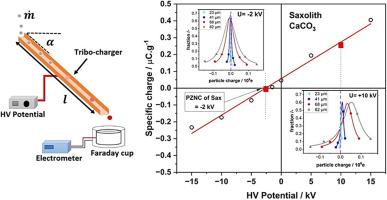Characteristics of powder charging behavior via forced triboelectric charging on an inclined chute
IF 4.5
2区 工程技术
Q2 ENGINEERING, CHEMICAL
引用次数: 0
Abstract
This study presents a novel method for selective charging of powders by dry triboelectric forced charging utilized as the first stage of material sorting in an electric field. In forced triboelectric charging, a high voltage is applied to the copper chute in which particles are charged during their transportation. In this research, the effect of the operating parameters of the chute, including mass flow rate, angle of inclination, and length, on the specific particle charge of limestone powders was investigated. In addition, the behavior of the charged particles in an electrostatic sorter was analyzed by evaluating their charge distribution after sorting. The results reveal that as the length of the chute increases, the specific charge asymptotically approaches a saturation value, which is determined by the high voltage applied. Furthermore, for a given chute length, the high voltage influences the amount and the sign of the specific particle charge, including a high voltage value at which the particles are neutral on average, i.e., the so-called point of zero net charge (PZNC). This PZNC is of particular interest for sorting out a target component from a powder mixture. However, if the mass flow rate is increased above a certain value, the specific charge decreases as the number of particle wall contacts is reduced due to stratification. Bipolar charge distributions were observed for all investigated high voltages, with the distribution width increasing with particle size to the power of 2.1. The modal value of the charge distribution shifts according to the difference in voltage applied to the PZNC.

倾斜溜槽上通过强制三电装料进行粉末装料的行为特征
本研究介绍了一种新型粉末选择性充电方法,即利用干式三电强迫充电作为电场中材料分拣的第一阶段。在强制三电荷化过程中,会在铜制溜槽上施加高压,颗粒在输送过程中会在其中带电。在这项研究中,研究了溜槽的运行参数(包括质量流量、倾斜角度和长度)对石灰石粉末特定颗粒电荷的影响。此外,还通过评估分拣后带电颗粒的电荷分布,分析了带电颗粒在静电分拣机中的行为。结果表明,随着滑道长度的增加,比电荷逐渐接近饱和值,这是由施加的高电压决定的。此外,对于给定的溜槽长度,高压会影响特定颗粒电荷的数量和符号,包括颗粒平均呈中性的高压值,即所谓的零净电荷点(PZNC)。零净电荷点(PZNC)对于从粉末混合物中分拣出目标成分尤为重要。但是,如果质量流量增加到一定值以上,由于分层作用,颗粒壁接触的数量会减少,因此比电荷会降低。在所有研究的高电压下都观察到了双极电荷分布,分布宽度随颗粒大小的增加而增加,其幂次为 2.1。电荷分布的模态值随施加在 PZNC 上的电压差异而变化。
本文章由计算机程序翻译,如有差异,请以英文原文为准。
求助全文
约1分钟内获得全文
求助全文
来源期刊

Powder Technology
工程技术-工程:化工
CiteScore
9.90
自引率
15.40%
发文量
1047
审稿时长
46 days
期刊介绍:
Powder Technology is an International Journal on the Science and Technology of Wet and Dry Particulate Systems. Powder Technology publishes papers on all aspects of the formation of particles and their characterisation and on the study of systems containing particulate solids. No limitation is imposed on the size of the particles, which may range from nanometre scale, as in pigments or aerosols, to that of mined or quarried materials. The following list of topics is not intended to be comprehensive, but rather to indicate typical subjects which fall within the scope of the journal's interests:
Formation and synthesis of particles by precipitation and other methods.
Modification of particles by agglomeration, coating, comminution and attrition.
Characterisation of the size, shape, surface area, pore structure and strength of particles and agglomerates (including the origins and effects of inter particle forces).
Packing, failure, flow and permeability of assemblies of particles.
Particle-particle interactions and suspension rheology.
Handling and processing operations such as slurry flow, fluidization, pneumatic conveying.
Interactions between particles and their environment, including delivery of particulate products to the body.
Applications of particle technology in production of pharmaceuticals, chemicals, foods, pigments, structural, and functional materials and in environmental and energy related matters.
For materials-oriented contributions we are looking for articles revealing the effect of particle/powder characteristics (size, morphology and composition, in that order) on material performance or functionality and, ideally, comparison to any industrial standard.
 求助内容:
求助内容: 应助结果提醒方式:
应助结果提醒方式:


